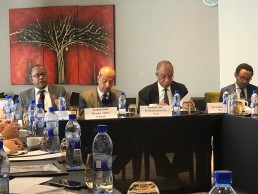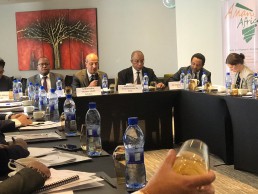The emerging New Architecture in the Relationship Between African Union (AU) and the Regional Economic Communities (RECs) in Peace and Security
As part of the ongoing institutional reform of the AU, one of the critical areas witnessing major legal and institutional change is the relationship between the AU and the Regional Economic Communities/Regional Mechanisms (RECs/RMs). Given the weight of the impact that changes in this area would carry for the AU and its PSC, the seminar was convened with the aim of discussing the ongoing review of the institutional and working relationship between AU and RECs, the clarification of the principles that govern the relationship and the modalities for their operationalization and the shape that the emerging new architecture of AU-RECs relationship is taking with particular focus on peace and security.
Concept Note
Breakfast Seminar on the: “The emerging New Architecture in the Relationship Between African Union (AU) and the Regional Economic Communities (RECs) in Peace and Security”
Introduction
The Constitutive Act of the African Union (AU) has among its key objectives the coordination and harmonisation of policies between Regional Economic Communities/Regional Mechanisms (RECs). RECs/RMs are also key actors in ensuring peace and security in their respective regions and also function as building blocks of the AU, including its peace and security regime.
With the expansion in the scope of engagement of the AU and RECs/RMs in responding to the peace and security needs of various parts of the continent, the need for achieving a more effective modus operandi for successful policy coherence and operational coordination has been on the rise. The 2008 Protocol on Relations Between the AU and the RECs was adopted with the purpose of ensuring closer coordination among the RECs and with the AU. While the adoption of the Protocol has been a great step forward in achieving better co-operation between the AU and RECs, its full realisation has encountered various challenges throughout the years following its adoption.
In the context of the changing dynamics of peace and security, the existing arrangements for coordination and mutually reinforcing joint action have increasingly proved inadequate. Notably, the application of the principle of subsidiarity has created some tension between the AU and RECs in certain cases. It comes as no surprise that clarifying the principles and modalities for such modus operandi in the relationship between the AU and RECs/RMs forms an important part of the ongoing AU institutional reforms.
In response to the increasing demand for a more collaborative and coordinated engagement by the AU and RECs/RMs and within the framework of the institutional reform of the AU, a major process for overhauling the legal and institutional framework governing the relationship between the AU & RECs/RMs has been underway.
Objectives
The aim of the seminar is to appraise and reflect on the ongoing process for the reform of the legal and institutional framework for AU-RECs/RMs relationship. Within this context the Seminar seeks to interrogate the following issues:
1. What are the legal and institutional changes being introduced to revamp the modus operandi in the relationship between the AU and RECs/RMs?
2. What mechanisms could best improve and institutionalize the relationships between AU PSC and RECs/RMs policy organs in charge of peace and security including bolstering the establishment of peace and security policy organs of RECs/RMs that don’t have one?
3. What measures could be taken to enable RECs/RMs to adequately provide substantive and continuous inputs to the PSC decision-making process in conflict prevention, management and resolution and vice-versa?
4. How to facilitate the establishment of modalities for timely and coordinated responses to crises through enriching engagements between the AU PSC and RECs/RMs to effectively respond to and substantially reduce emerging threats?







